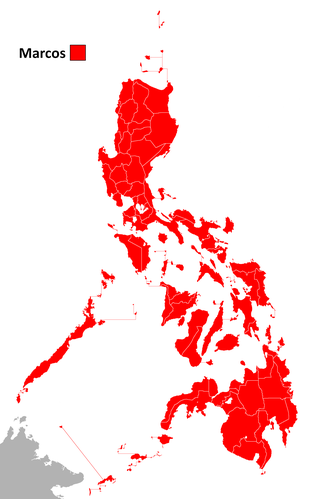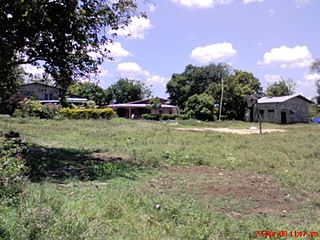
A barangay, historically referred to as a barrio, is the smallest administrative division in the Philippines and is the native Filipino term for a village, district, or ward. In metropolitan areas, the term often refers to an inner city neighborhood, a suburb, a suburban neighborhood, or even a borough. The word barangay originated from balangay, a type of boat used by a group of Austronesian peoples when they migrated to the Philippines.

In the Philippines, regions are administrative divisions that primarily serve to coordinate planning and organize national government services across multiple local government units (LGUs). Most national government offices provide services through their regional branches instead of having direct provincial or city offices. Regional offices are usually but not necessarily located in the city designated as the regional center.

Bacoor, officially the City of Bacoor, is a 1st class component city in the province of Cavite, Philippines. According to the 2020 census, it has a population of 664,625 people, making it the 15th most populous city in the Philippines and the second largest city in the province of Cavite after Dasmariñas.

Navotas, officially the City of Navotas, is a 1st class highly urbanized city in the National Capital Region of the Philippines. According to the 2020 census, it has a population of 247,543 people.
Elections in the Philippines are of several types. The president, vice-president, and the senators are elected for a six-year term, while the members of the House of Representatives, governors, vice-governors, members of the Sangguniang Panlalawigan, mayors, vice-mayors, members of the Sangguniang Panlungsod/members of the Sangguniang Bayan, barangay officials, and the members of the Sangguniang Kabataan are elected to serve for a three-year term.

Alaminos, officially the City of Alaminos, is a 4th class component city in the province of Pangasinan, Philippines, and is known for being the home of the Hundred Islands National Park, which is composed of 124 islands and is located off the coast of Barangay Lucap. According to the 2020 census, it has a population of 99,397 people. The city is named after Juan Alaminos y de Vivar, a former governor-general of the Philippines.

The 1981 Philippine presidential election and national referendum was held on June 16, 1981. President Ferdinand E. Marcos of the Kilusang Bagong Lipunan (KBL) defeated retired general and World War II veteran Alejo Santos of the Nacionalista Party in a landslide victory. Most opposition parties boycotted the election as a sign of protest over the 1978 election for the Interim Batasang Pambansa, which they condemned as fraudulent. At the same time, a national referendum was held on the question in holding elections for barangay elections in 1982.
The Philippines is divided into four levels of administrative divisions, with the lower three being defined in the Local Government Code of 1991 as local government units (LGUs). They are, from the highest to the lowest:
- Regions are mostly used to organize national services. Of the 17 regions, only one—the Bangsamoro Autonomous Region in Muslim Mindanao—has an elected government to which the central government has devolved competencies.
- Provinces, independent cities, and one independent municipality (Pateros)
- Component cities and municipalities within a province
- Barangays within a city or municipality

Kay-Anlog is a component barangay of the city in Calamba, Laguna, Philippines, situated in the southern part of the city, adjacent to the barangays of Milagrosa, Burol, Bubuyan, and Ulango.

Sangguniang Kabataan is a council meant to represent the youth in each barangay in the Philippines. It was put "on hold", but not quite abolished, prior to the 2013 barangay elections. In January 2016, the Sangguniang Kabataan Reform Act was signed into l,aw which made some significant changes to the SK and initially scheduled new elections for October 2016. In March 2017, the elections were postponed anew to May 2018.

The 15th Congress of the Philippines, composed of the Philippine Senate and House of Representatives, met from July 26, 2010, until June 6, 2013, during the first three years of Benigno Aquino III's presidency. The convening of the 15th Congress followed the 2010 general elections, which replaced half of the Senate membership and the entire membership of the House of Representatives.
Synchronized Barangay and Sangguniang Kabataan (SK) elections were held on October 25, 2010, in the Philippines. The electorate elected in nonpartisan elections, the Barangay chairman also known as the Punong Barangay and members of the Sangguniang Barangay for voters aged 18 and above. While voters aged 15 to 17 voted for the chairman of the Sangguniang Kabataan and members of the Katipunan ng mga Kabataan. Due to funding issues, the Commission on Elections opted to use the manual voting system instead of the automated elections as was done in the last 2010 national elections.
Barangay elections were held on Monday, October 28, 2013. The election shall elect the Punong Barangay, more commonly known as barangay captains, and members of the Sangguniang Barangay, or barangay council, in 42,028 barangays throughout the Philippines whose terms start on November 30, 2013. Barangays are the smallest local government unit in the Philippines.
Local elections were held in the Philippines on May 13, 2013, the same day and on the same ballot as national elections. Elected were governors, mayors and council members of Philippine provinces, Philippine cities and Philippine municipalities. Separate elections for barangay officials were held on October.

A general election in the Philippines took place on May 9, 2016, for executive and legislative branches for all levels of government – national, provincial, and local, except for the barangay officials.
Barangay elections in the Philippines were held on May 14, 2018. The election shall elect the Punong Barangay, more commonly known as barangay captains, and members of the Sangguniang Barangay, or barangay council, in 41,948 barangays (villages) throughout the country whose terms start on June 30, 2018. Barangays are the smallest local government unit in the Philippines.

The 2022 Philippine general election took place on May 9, 2022, for the executive and legislative branches of government at every level – national, provincial, and local – except for the barangay officials.
Barangay and Sangguniang Kabataan elections (BSKE) in the Philippines are scheduled to be held on October 30, 2023. The barangay, commonly translated as "village", is the smallest government authority in the country. The election shall elect the barangay captain or the chief executive of the barangay, and seven of eight members of the Sangguniang Barangay, or barangay council, in 42,027 barangays throughout the country.

Santo Cristo (PSGC:) is a Quezon City barangay located in North EDSA, a busy commercial area of shopping malls, transport hubs and office buildings.












